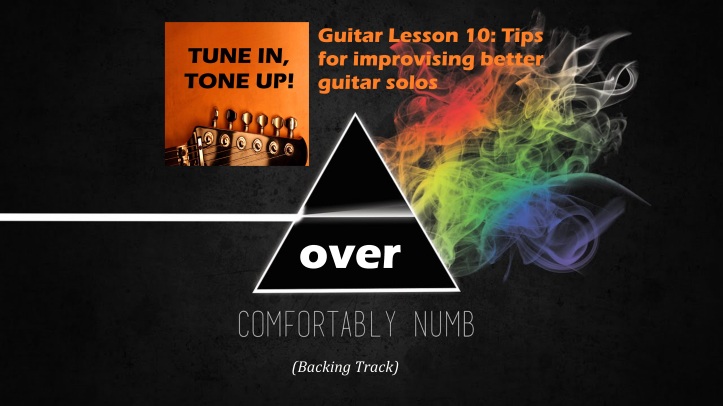
Introduction:
I’m sure that I am not alone in finding this element of my playing the most challenging and about which I still have so much more to learn, but also the most rewarding and inspiring thing to practise. With that in mind, I wanted to find out some more tips and thoughts from the benefit of Dan’s experience and skill about how to make my solos and improvising more interesting and enjoyable to listen to.
Dan as ever had loads of brilliant tips, advice and strategies for me to consider and practise. I chose to use ‘Comfortably Numb’ as backing for this as the chord changes for the solo follow a repetitive pattern and the progression is atmospheric and immediately recognisable. I also think that David Gilmour’s solos are full of deep tone and carefully chosen chord tones with a lot of space and soulful bending. Pink Floyd are one of my big musical influences and I wanted to gain some insights into Gilmour’s playing (something we return to in our next lesson in two weeks time on effective use of delay for a different sound).
This post follows this theme and includes my research into additional listening, video techniques and demonstrations. Don’t forget to look to the bottom of my post for further research and listening – I have attached some good videos to use.
I want to share Dan’s playing here – each round of chords I call out a ‘theme’ for him to use in his playing. Dan then completes a round of the chord progression using that theme. Completely unrehearsed, I’m sure that you’ll agree this is some very impressive playing and a really useful concept to run with:
Themes called out:
- bending
- sliding
- arpeggios
- tapping
- open strings
- harmonics
- descending
- ascending
- string skipping
- vibrato
- pentatonics
- pinch harmonics
Our podcast episode is here:
This is the backing track we use:
Chronological outline of this lesson:
- We discuss the idea of improvisation and define it
- Dan asks me for a backing track idea and I put forward the idea of using Comfortably Numb
- We find a good version of this online (see the video above).
- I have a go at improvising – the first time round is not great, but hopefully you’ll hear my mistakes and perhaps this will give you something also to work on in your own playing. One thing Dan identifies is my use of my little finger in pentatonic bends, as he advises using the third finger instead for me to have the strength and feel to hit the right notes.
- Dan demonstrates some ideas and then passes over to me.
- My playing here is a bit better, but raises the question of how much gain to use and what volume you want on the guitar to start a solo with.
- Another round and Dan picks up on the common error made by guitarists to feel the need to move around the pentatonic positions, when he felt that I could have explored the 12th to 14th fret area further and made use of some further use of that area. So we both have another go, limiting ourselves to this area.
- Finally we move onto the topic of themes to avoid a meandering solo lacking direction or energy. Dan demonstrates what he means by playing rounds of the chord progressions with me calling out a theme for him to use for that round:
This lesson was really inspiring and I certainly picked up loads of great ideas. Please be kind to my playing. When I listen back and compare with Dan’s, there are incorrect notes, poor bends, rhythmic mistakes and other errors which render them much less listenable than Dan’s playing; however, this is what I’m here for and it is so useful to me to hear these problems in my playing. I hope that you find something useful from listening too.
Further research and videos:
A superb guitar cover of the solos from Comfortably Numb. The video is very clear and the playing is excellent – I really find that this is a great way to pick up the ideas, themes, techniques and notes of a solo.
I found this backing track by Quist – which is amazing. Quist first plays a solo to give you some ideas and then leaves the backing track running for you to practise over. In this case it goes from Comfortably Numb to Great Gig in the Sky and then returns to Comfortably Numb after a while.
An amazing version of Comfortably Numb for PULSE tour, the solo starts at 4 minutes and 55 seconds. Check it out!
Our philosophy:
Our podcast and blog has organically grown and I do appreciate all feedback, follows, likes and suggestions. It is now meant to be used as a way of introducing some ideas and themes which are useful to be aware of as you develop your practice on your guitar. Hopefully, you’ll find them useful in the audio format which we release them in as this way you can listen while doing another task and then use the suggestions we raise in each episode to do some extra research and practise of your own. It is my hope that you find this a useful listening exercise, to support the development of your musical ear. It is good to think that you, our listeners, are not immediately looking for tabs, but rather using your ear to find the notes yourself. This is so important to develop your feel, phasing and dynamics and can be lost if you spend too much time relying on tabs.
The way I myself find these lessons useful is to study in great depth what Dan introduces me too, including guidance on who or what to listen to, and I feel lucky that I can return to each lesson and not forget all his excellent advice as was the case prior to the recording of our lessons. I also find studying my own mistakes hugely valuable, I hope you do too
I plan to continue producing posts for each podcast episode, linking in some guitar lesson videos from online tutors and guitar covers from players out there. I hope that you will find our lessons and blog useful and that we help you to see the big picture. I certainly think that I could have organised my own practice to be more effective earlier in my own learning and if this had been the case, then I would have developed my skills more quickly and easily. For further ideas about this I would encourage you to spend some time looking at my article on guitar practice, apps and software and then dedicate some time NOW into learning to recognise intervals, rhythms and chords by ear. This will hugely fast-track your learning.
I hope you enjoy this lesson as much as I did and that you keep listening. If you want to support us further, then like us on Facebook, follow us on SoundCloud, Twitter or Google+ and subscribe, rate and review on iTunes to help us conquer the Apple algorithms. You can also follow my online magazine: Lessons and Gear for Guitar Geeks and Fanatics
Good luck on your musical journey!
Gary and Dan


